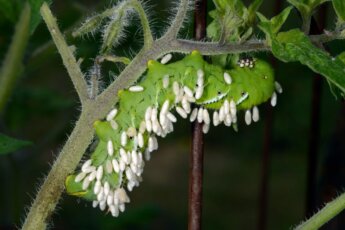Tomato troubles — too little calcium, too much hornworms

Hornworms covered in white cocoons should be left alone as these cocoons are braconid wasp larvae, which feed on the hornworms, helping to control their populations, which in turn, minimizes their damage to tomatoes.
By Ann Hazelrigg, University of Vermont Extension
As you harvest the first tomatoes of the season, you may notice that some of the fruit is not perfect. Blossom end rot, a physiologic disorder, results in dry, sunken, brown areas on the blossom end or bottom of the fruit.
Blossom end rot also can occur on peppers but often is on the sides of the fruits rather than the bottom. The cause of this unsightly rot is due to the insufficient calcium in the fruit despite having sufficient calcium in the soil, stems or leaves. The disorder is linked to fluctuating soil moisture causing poor movement of calcium into the fruit.
It often occurs early in the season because the plants are growing rapidly, and the roots can’t always keep up with the plant’s needs. Anything that affects the roots adversely could result in blossom end rot, such as drought, cultivating too close to the plant or waterlogged soils.
Certain cultivars may be more susceptible to blossom end rot than others. Levels of calcium may be low in the soil, but this can only be determined by a soil test. You can get your soil tested through the University of Vermont Extension Agricultural and Environmental Testing Lab.
To avoid this disorder in the future, try to maintain a consistent supply of soil moisture. Tomatoes typically need about an inch of water per week either through drip irrigation or rainfall when they are rapidly growing.
Mulching tomatoes once the soil warms up with either straw or plastic will help even out fluctuating soil moisture. Damaged fruit should be picked and discarded so the tomato plant can put energy into the next tomatoes, which are hopefully free of blossom end rot.
Another tomato problem rearing its ugly head in Vermont gardens now is the tomato or tobacco hornworm. These colorful green caterpillars are larvae of the five-spotted hawk moth and Carolina sphinx moth, respectively.
The tomato hornworm has a black horn on the last abdominal segment and has eight white, V-shaped marks on each side of its body. The tobacco hornworm looks similar but has seven diagonal white stripes with black margins along its body and an orange-red tail spine or horn.
They both start out small, but eat like a teenager, growing very fast and are fully grown in three to four weeks at 4 inches in length. They are often well camouflaged and difficult to see, but if you notice a lot of tomato foliage missing, and you see little green grenade-like frass or droppings on the foliage, you know a hornworm pest is nearby.
The white marks on the caterpillars glow in the dark under black lights. In fact, many high tunnel tomato growers search for the pest at night using a black light flashlight and destroy them as they find them hidden in plants.
After feeding for three to four weeks, the caterpillar drops to the soil near the base of the plant and burrows 4-6 inches into the soil and pupates until next spring. The best control for these pests is to hand pick and drop them into soapy water.
There is a beneficial wasp that is an important natural enemy of hornworms. The braconid wasp lays an egg inside the caterpillar, and the larvae feed inside until they emerge and attach themselves to the caterpillar body. There they pupate in white cocoons that are easily seen with the naked eye.
This process ultimately kills the hornworm. If you find a parasitized hornworm with the white pupae, it is best to leave it alone, so the wasp can continue its lifecycle and continue to parasitize hornworms in the future.
(Ann Hazelrigg is the University of Vermont Extension plant pathologist and director of the university’s Plant Diagnostic Clinic.)
